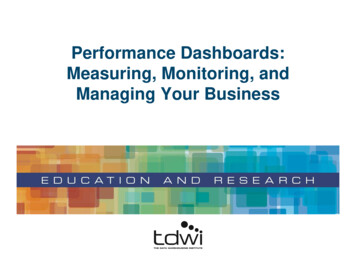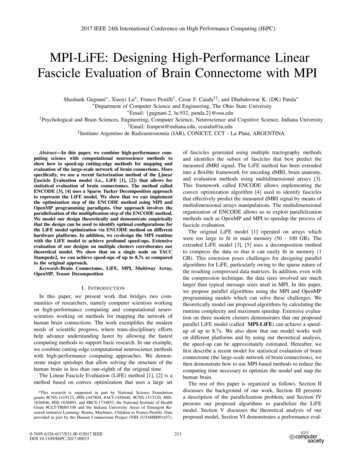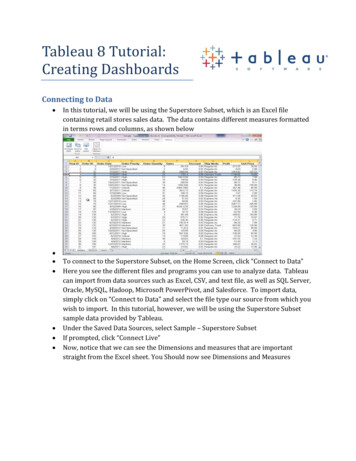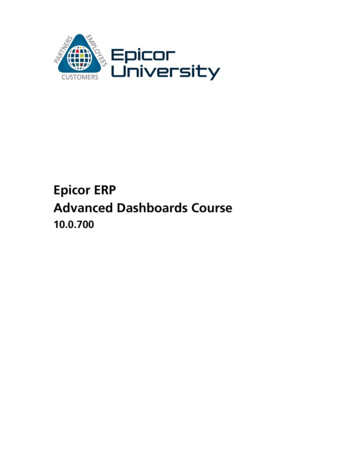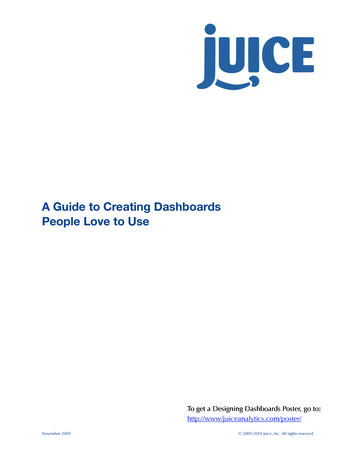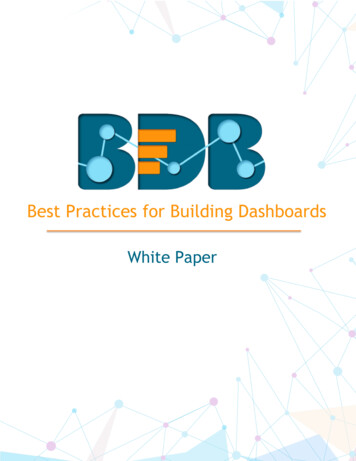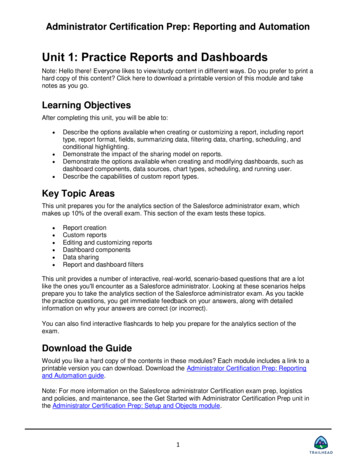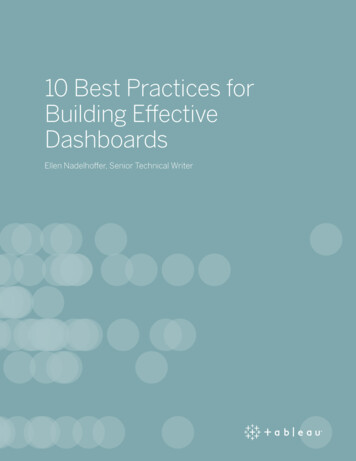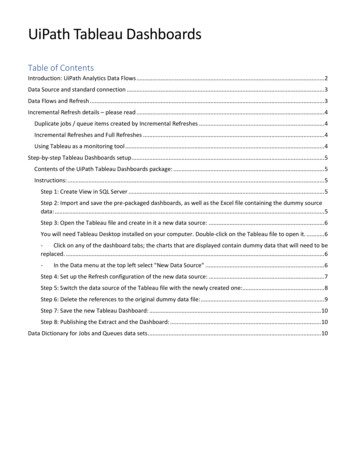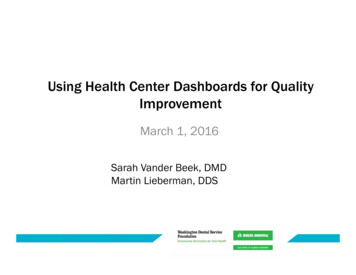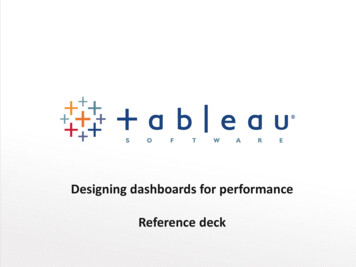
Transcription
Designing dashboards for performanceReference deck
Basic principles1.Everything in moderation2.If it isn’t fast in database, it won’t be fast in Tableau3.If it isn’t fast in desktop, it won’t be fast in server 2012 Tableau Software Inc. All rights reserved.
Data sourcesFile-based data sourcesRelational data sourcesOLAP data sourcesWeb-based data sources 2012 Tableau Software Inc. All rights reserved.
File-based data sourcesImport into Tableau’s fast data engineMicrosoft JET driver 255 columns, 255 characters No COUNT DISTINCT or MEDIAN Files greater than 4GB in sizeTableau text parser Used when no data modelled
Relational data sourcesIndexes On all columns part of table JOINs On any column used in FILTERReferential integrity Primary and foreign key explicitly defined– Helps bypass integrity checks Join cullingPartitioning Split larger table into smaller, individual tables Partition across dimension
Relational data sourcesNULLs Define dimension as NOT NULL Increase effectiveness of indexesCalculations Very complex calculations in a view or function within DB Create a custom SQLSummary tables Summarize data to higher level of aggregation
Other data sourcesOLAP data sources Underlying language differences– Metadata definition– Filtering– Totals and aggregations– Data blendingWeb-based data sources “Connect live” not an option Extracts can be refreshed– Automated and scheduled
QueriesUnderstanding the queryMultiple tables vs. custom SQLBlending vs. joining 2012 Tableau Software Inc. All rights reserved.
Understanding the querySlow-running visualisation Time it takes to query Time to stream records backNumber of records Large number vs. smaller number of aggregated recordsDesktop log files
Multiple tables vs. custom SQLMultiple tables Dynamically create SQL based on fields Join culling to drop unused dimension tables– Referential integrityCustom SQL Never deconstructed, and executed atomically Use in conjunction with Tableau’s data engine Context filters materialise results in a temp table Include parameters in SQL statements
Blending vs. joiningMore than one data source Blend data or federated database systemJoin is better on same data source Improve performance Improve filtering controlBlend is better across data sources Too many records for a join to be practical Display summary and details at the same time
ExtractsCreating extractsAggregated extractsOptimizing extractsExtracts vs. live connections 2012 Tableau Software Inc. All rights reserved.
Creating extractsFactors Database technology Network speed Data volumes Workstation specs– Fast CPU with multiple cores– Lots of RAM– Fast I/OCreation requires temp disk space Up to square of the size of resulting extract fileCreate extract on workstation, populate on server
Aggregated extractsHelps improve performance Aggregate to summary level Filter unnecessary values Hide all unused fieldsMultiple level of detail across extracts Querying from higher aggregation to detail
Optimizing extractsOptimize deterministic calculations String manipulations and concatenations Groups and setsNon-deterministic calculations not storedCheaper to store data than recalculate
Extracts vs. live connectionsSpeed of data engine is relativeData engine is faster than Non-optimized data base File-based data sourceData engine probably slower than Big cluster of fast machinesAggregate extracts to offload summary-style analysis Detailed source data in data warehouse
FilteringFiltering categorical dimensionsFiltering datesContext filtersQuick filtersUser filters 2012 Tableau Software Inc. All rights reserved.
Filtering categorical dimensionsDiscrete filters can be slower Keep only and exclude perform poor– Complex WHERE clause– Join on a temp tableRanged filters can be faster Faster than large itemised list of discrete values Faster when increasing dimensions cardinalityIndexes impact efficiency of filters
Filtering datesDiscrete dates or date levels Can result in poor query execution– Tables not partitioned on DATEPART Data extract can optimise performance– DATEPART materialised in extractRange of contiguous dates Very efficient for query optimisers– Leverage indexes and partitionsRelative to a specific date Uses ranged date filter
Context filtersAll filters are computed independentlySet one or more filters as context filters Any other filters are defined as dependent filters Writes filter result set to temp table– Subsequent filters and queries on smaller datasetCreation of temp table expensive activity Context filters not frequently changed by userCustom SQL statements can be optimised
Quick filtersToo many quick filters will slow you down ‘Only Relevant Values’ Lots of discrete listsTry guided analytics over many quick filters Multiple dashboards with different levels Action filters within a dashboard
Quick filtersEnumerated quick filters can be slow Requires a query for all potential field values––––––Multiple value listSingle value listCompact listSliderMeasure filtersRanged date filtersNon-enumerated quick filters can be helpful Do not require field values––––Custom value listWildcard matchRelative date filtersBrowse period date filtersPerformance at the expense of visual context for end user
Quick filtersShow potential values in 3 different ways All values in database– No need to re-query when other filters changed All values in context– Temp table regardless of other filters Only relevant values– Other filters are considered
Quick filter alternativesCreate a parameter and filter based on users’ selection PROS– Do not require a query before rendering– Parameters calculated fields complex logic– Can be used to filter across data sources CONS– Single-value selection only– Selection list cannot be dynamic
Quick filter alternativesUse filter actions between views PROS– Supports multi-value selection– Evaluated at run-time to show a dynamic list– Can be used to filter across data sources CONS– Filter actions are more complex to set up– Not the same UI as parameters or quick filters– Source sheet still needs to query the data source
User filtersMore data source I/O Need to ask exact same query againMore cache space required Each user session creates own query results and model cacheCaches being cleared can result in more I/O
CalculationsBasic and aggregate vs. table calculationsCalculations vs. native featuresPerformance techniques 2012 Tableau Software Inc. All rights reserved.
Basic and aggregate calculationsBasic and aggregate calculations Expressed as part of the query sent to data source Calculated by the database Basic calculations scale very well– Tuning techniques can improve performanceTable calculations Calculated locally on query results returned– Generally done over a smaller set of records If performance is slow – Then push calculations to data source layer– Consider aggregated data extracts
Calculations vs. native featuresNative features often more efficient than a manual calculation Grouping dimension members together– Consider using groups Grouping measure values together into ‘bins’– Consider using bins Changing displayed values for dimension members– Consider using aliases
Performance techniquesData type used has a significant impact on performance Integers are faster than Booleans Both are faster than StringsUse Booleans for basic logic calculations Bad– IF [DATE] TODAY() THEN “TODAY” ELSE “NOT TODAY” END Good– [DATE] TODAY()String searches FIND() slower than CONTAINS() CONTAINS() slower than wildcard match quick filter
Performance techniquesParameters for conditional calculations Take advantage of ‘display as’– Integer values for calculation logicVALUEYEARQUARTERMONTHWEEKDAYDISPLAY ASYEARQUARTERMONTHWEEKDAYVALUE12345DISPLAY ASYEARQUARTERMONTHWEEKDAY
Performance techniquesDate conversion Numeric field to a string to a date is inefficient– Bad– DATE(LEFT(STR([YYYYMMDD]),4) “-“ MID(STR([YYYYMMDD]),4,2) “-“ RIGHT(STR([YYYYMMDD]),2))Keep numeric field and use DATEADD()– Good–DATEADD(‘DAY’, [YYYYMMDD]%100-1, DATEADD(‘MONTH’, INT(([YYYYMMDD]%10000)/100)-1, DATEADD(‘YEAR’,INT([YYYYMMDD]/10000)-1900, #1900-01-01#)))Date functions NOW() for time stamp TODAY() for date level
Performance techniquesLogic statements ELSEIF ! ELSE IFIF [REGION] "EAST" AND [CUSTOMER SEGMENT] "CONSUMER"THEN "EAST-CONSUMER"ELSE IF [REGION] "EAST" AND CUSTOMER SEGMENT] "CONSUMER"THEN "EAST-ALL OTHERS"ENDEND would run much faster as:IF [REGION] "EAST" AND [CUSTOMER SEGMENT] "CONSUMER"THEN "EAST-CONSUMER"ELSEIF [REGION] "EAST" AND [CUSTOMER SEGMENT] "CONSUMER"THEN "EAST-ALL OTHERS"END but this is faster still:IF [REGION] "EAST" THENIF [CUSTOMER SEGMENT] "CONSUMER" THEN"EAST-CONSUMER"ELSE "EAST-ALL OTHERS"ENDEND
Performance techniquesSeparate basic and aggregate calculations When using extracts and custom aggregations– Divide calculations into multiple parts– Row level calculations on one calculated field– Aggregated calculations on second calculated field
Dashboards and viewsViewsDashboards 2012 Tableau Software Inc. All rights reserved.
ViewsOnly fetch and draw what you need Remove unnecessary fields from level of detailCharts vs. crosstabs Marks display faster than a tabular report– Rendering a text table consumes more memory Tableau is not a back door data extract process– Leverage aggregate to detail action filtersRemoving unnecessary geographic roles Save time to lookup generated latitudes & longitudes
ViewsBlending vs. custom geographic roles Custom geocoding embeds entire GEOCODING.FDB– Significant increase in TWBX file size Joining or blending geographic data is smaller size– Save only relevant custom geographic data
DashboardsLess views, less quick filters Each view requires at least one query Each quick filter requires at least one query Can result into a lot of I/O before rendering Dashboards process views from same data source in a serial fashionTurn off tabs Must process every view in every tab– Need to understand structure of tabs for actions or filters Reducing tabs improves performance– Try ‘:tabs no’
Dashboards“Exclude all values” Avoids expensive query of asking for all dataFixed size dashboards Different window sizes mean views are drawn differently– VizQL server must render view separately for each user “Automatic (Fit To Window)” has low cache hit rateContainer considerations Consider reducing excessive usage of containers
Tools to analyze performanceTableau desktop messagesLog filesDatabase performance monitorsTableau 8 performance metrics 2012 Tableau Software Inc. All rights reserved.
Tableau desktop messagesExecuting query Process– Execute a query to return records for the view Investigate– Review log file to see queries taking long time Possible solution– Consider calculation, query and filter techniques
Tableau desktop messagesComputing View Layout Process– Tableau rendering display on all data received Investigate– Slow-running table calculations– Very large crosstab– Lots of marks rendered Possible solution– Review techniques for calculation optimisation and view design
Tableau desktop messagesComputing quick filters Process– Tableau is processing quick filters for view(s) Investigate– Long time rendering and refreshing quick filters Possible solution– Consider not using ‘show relevant values’– Consider not using enumerated quick filters– Review techniques for filter performance and view design
Log filesUnderstand where bottlenecks are occurring Information on what Tableau is doing Tableau communication with the data source Time taken by each Tableau stepFor Tableau Desktop C:\Users\username\Documents\My Tableau Repository\LogsFor Tableau Server, the VizQL log file: C:\ProgramData\Tableau\Tableau Server\data\tabsvc\vizqlserver\Logs
Database performance monitorsDatabase performance monitors Insight on queries hitting your DB Understand how database processes them Advice on additional tuningTableau 8 performance metrics Turn on to record metrics
Performance metrics V8Interpret performance recording Timeline– Workbook, dashboard, worksheet Events– Event nature and duration Query– Executing query in either timeline or events
Performance metrics eventsComputing layouts If layouts are taking too long, consider simplifying your workbook.Connecting to data source Slow connections could be due to network issues or issues with the database server.Executing query If queries are taking too long, consult your database server’s documentation.Generating extract To speed up extract generation, consider only importing some data from the original data source.Geocoding To speed up geocoding performance, try using less data or filtering out data.Blending data To speed up data blending, try using less data or filtering out data.Server rendering You can speed up server rendering by running additional VizQL Server processes on additional machines.
Tableau serverGeneral performance guidelinesCaching 2012 Tableau Software Inc. All rights reserved.
General guidelinesGeneral guidelines Use a 64-bit operating system– Ensures 64-bit version of Tableau data engine– 32-bit processes have access to more memory Add more cores and memoryConfiguration Schedule extract refreshes for off-peak hours Check the VizQL session timeout limit– Default is 30 minutes– Idle session still consumes memory– Change using tabadmin– vizqlserver.session.expiry.timeout.setting Assess your process configuration
CachingMaximise cache use Reuse image tile and model caches–Set dashboard size rule to ‘exact size’Tuning caches Tableau server configuration utility–Minimise queries–Balanced–Most up-to-date»“:refresh yes” to view URL Tabadmin– Model cache» vizqlserver.modelcachesize:30– Query cache» vizqlserver.querycachesize:64
FIN
Geocoding To speed up geocoding performance, try using less data or filtering out data. Blending data To speed up data blending, try using less data or filtering out data. Server rendering You can speed up server rendering by running additional VizQL Server processes on
